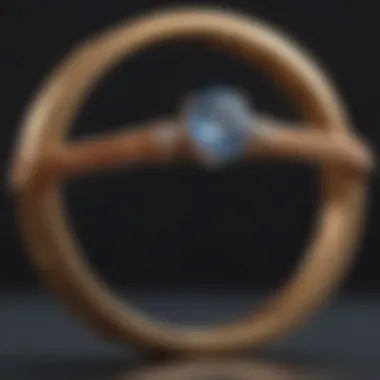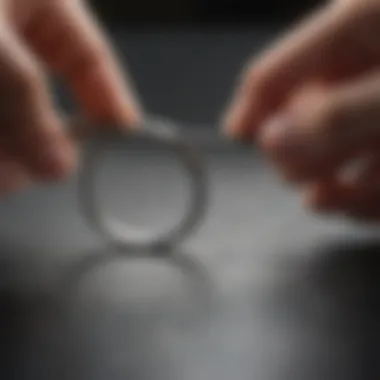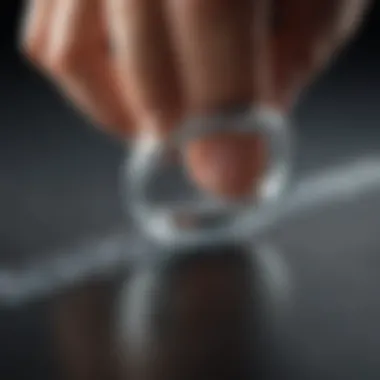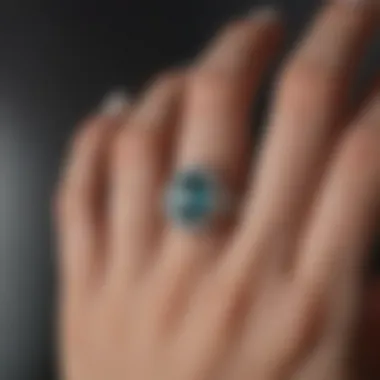Techniques for Measuring Ring Sizes Without a Sizer


Intro
Understanding how to measure a ring size accurately can save you a lot of hassle, be it for yourself or for someone special. Many people find themselves in a pickle when they want to buy a ring but lack a professional sizer. It's not always possible to waltz into a jewelry store, especially if you're tighter on time or prefer a more personal approach.
There are effective techniques to measure ring sizes using common household items. This article explores these methods, ensuring you can still achieve a comfortable fit without having to rely on specialized tools. Whether you're crafting a piece for yourself or hunting for the perfect gift for a loved one, knowing how to measure correctly can make the world of difference.
As we dive deeper, you’ll find various tips and tricks that shed light on this process—one that many overlook. Let’s kick off with some practical advice that gets right to the point.
Understanding Ring Size
When it comes to jewelry, particularly rings, size matters. Understanding ring size isn’t just about fitting a piece around your finger; it's about ensuring comfort, style, and overall satisfaction. The significance of this knowledge goes beyond aesthetics; it can also impact the emotional resonance of what could be a cherished piece of art.
Importance of Accurate Sizing
Accurate ring sizing can make the difference between a ring that feels like a weighty anchor on your finger or one that dances gracefully during every movement. Imagine gifting a beautifully crafted ring only to find it slides off at the first gust of wind or, conversely, feels like a vice. Such situations can lead to disappointment and even embarrassment.
Consider that rings are often symbols of commitment, love, or achievement. Be it an engagement, anniversary, or promotion, wearing a ring that fits snugly can elevate the significance of the occasion. Each time an individual looks down at their hand, a proper fit reminds them of the moment it represents.
Common Measurement Units
When discussing ring sizes, two primary systems are used globally: the US sizing system and the metric (or circumference) system. The US system employs a straightforward numerical scale — for example, a size 7 represents certain diameter dimensions. Meanwhile, the metric approach focuses on circumference measured in millimeters. This can be perplexing, especially for those purchasing internationally.
Additionally, a standard, often overlooked, aspect relates to half-sizes. The availability of half-sizes underlines the necessity for precise measurements, especially for those whose bodies do not conform to whole numbers. Here’s a brief overview:
- US System: Standard sizes range from 3 to 13.5 with half-sizes available.
- Metric System: Usually measured in millimeters, with common sizes around 50mm to 70mm in circumference.
Variations in Ring Styles
Rings come in all shapes and styles, which influences sizing quite a bit. Consider a wide band ring. What might fit snugly for a delicate band may not sit well if it’s accompanied by a wider counterpart. A heavier ring feels entirely different than a lightweight one.
Specific styles, like those with intricate designs or embellishments, can create pressure in unexpected places. A ring that sits majestically on the finger can become uncomfortable if the sizing isn’t done with consideration of these variations.
Moreover, individuals with larger knuckles might find that rings fit easily over the knuckle but then get stuck at the base, creating a frustrating experience of trying to get the ring on and off. Thus, knowing the specific style of ring and its impact on size is crucial.
Understanding these elements of ring size helps individuals make more informed decisions, ensuring that their rings not only fit well but also feel great.
Why Measure Without a Sizer?
Understanding why one might measure their ring size without a sizer is crucial. This exploration delves into the practical realities many face and highlights the perks of home-based techniques.
Convenience of At-Home Measurements
One of the most appealing aspects of measuring a ring at home is the sheer convenience it offers. Life can be busy—trying to juggle work, social commitments, and personal projects often leaves little time for errands. With everything from ring measurement to major purchases occurring at our fingertips, employing household items makes the task manageable.
Imagine it’s late at night and you suddenly realize your favorite piece of jewelry needs resizing. Rather than scrambling to find a professional or fitting in a trip to a jewelry store, grabbing some everyday materials like string or paper allows you to get started immediately. This accessibility helps eliminate the stress of scheduling conflicts and the logistics of picking up or dropping off at a jeweler. You can measure when it suits you without taking a chunk out of your day.


Furthermore, measuring from the comfort of your home can lead to a more relaxed experience. Many people feel intimidated by the thought of visiting professionals and showcasing their fingers for sizing. By using techniques available at home, you can take your time, repeat measurements, and ensure you achieve the correct size, all while sipping on your favorite beverage.
Limitations of Sizing Tools
Despite the advantages of specialized sizing tools, they come with their limitations, which can complicate the process of determining ring size accurately. Common sizing options, such as plastic sizers or metal bands, are often designed for general use, meaning they might not fit all finger shapes or sizes. This is especially true for individuals with wider knuckles or those whose fingers differ slightly in size, presenting a problem when relying solely on standard tools.
Many tools also require knowledge about how to use them correctly. Misunderstanding the placement or measurement technique can lead to incorrect sizing, resulting in discomfort or even the loss of rings. Not to mention that many sizing kits are difficult to find in a local store, requiring online ordering and waiting time, which delays your access to accurate results.
Another point to consider is the cost. Purchasing a high-quality sizing tool may put a dent in your wallet, particularly if you only need it for a one-time measurement. In contrast, utilizing common household items is not only economical but also promotes sustainability, making it a more environmentally friendly option.
"Avoiding specialized tools not only cuts down on unnecessary expenses but also provides a sense of empowerment in managing one's own jewelry measurements."
All said, while traditional sizing tools have their place, they often fail to accommodate the unique situations faced in ring measurement at home. Using simple techniques with familiar materials bridges the gap between convenience and accuracy in a practical way.
By carefully considering both the benefits and drawbacks of home measuring, one can go forth with a confident approach, choosing methods that resonate with their particular needs.
Techniques for Measurement Using Common Objects
When it comes to measuring a ring without the convenience of a sizer, utilizing everyday items can be quite the game changer. This approach not only makes the task accessible, but it also lays the groundwork for accurate sizing. By employing these techniques, individuals can ensure a good fit without the need for professional assistance, allowing for a practical solution amidst the challenges of ring sizing.
Using String or Thread
Selecting the Right Material
When opting for a string or thread to gauge your ring size, the choice of material significantly impacts accuracy. Ideally, using a thin, flexible string or a fine thread is best. These options conform easily to the shape of your finger. However, using a thicker material may lead to successions in readings. Some individuals choose a soft measuring tape, which can provide an even better fit since it molds to any irregularities in finger size. The ease of manipulation and the availability of such materials make them friends of those who work from home or want a simple method.
How to Wrap and Measure
The significance of the wrapping technique cannot be underestimated. To effectively measure, wrap the string around the thickest part of your finger, typically where the knuckle resides, ensuring that it snugly fits without constricting blood flow. Mark the point where it overlaps. Later, flatting the string and measuring it against a ruler will yield your finger's circumference. While this method is quite effective, be cautious of pulling the string too tightly because that could lead to an inaccurately smaller size.
Utilizing Paper Strips
Preparing the Paper Strip
Turning a simple paper strip into a measuring tool can be surprisingly efficient. Use a narrow strip of paper, about 1cm wide and 15cm long. The key here is in width; a narrower strip allows for easier handling and a better fit around your finger. This technique is often favored due to its simplicity and the fact that most households have paper readily available, making it a go-to option when precise sizing is needed without special gadgets.
Measuring the Circumference
Once your paper strip is prepared, wrap it around your finger as previously described with the string method, marking the point where it overlaps. The crucial aspect here is to ensure the paper doesn’t slide or loosen while you’re wrapping. This technique, while straightforward, requires some diligence, as creases or folds may lead to inaccuracies. After marking, use a ruler to measure the marked distance. This will directly correspond to your ring size.
Employing Existing Rings
Choosing the Correct Ring
If you already own a ring that fits well, using it as a reference is a wise choice. Pick a ring that you wear comfortably on the finger you wish to size. Ensure that the ring’s inner diameter is smooth and free from jagged edges, as irregularities can skew the measurement. This technique is beneficial as it requires no additional materials and can be done on a whim while ensuring a more accurate fit.
Comparative Measurement Techniques


The comparative measurement can be accomplished using a ruler or caliper. Simply measure the diameter of the chosen ring by placing it flat against a ruler, or, for more precision, using dissecting calipers if available. This method stands out due to its reliability and straightforward nature. However, depending on the size of the existing ring, this approach might be less effective for those needing a ring for a different finger than the one where the original is worn.
A note of caution: Always remember to account for any variations in style or shape when determining the size of a new ring against an existing one. Different styles can fit differently due to materials and design.
Using household objects to measure a ring size opens the door for everyone to find a comfortable fit without needing specialized tools. Though these methods seem uncomplicated, they require a careful, methodical approach to yield the best possible results.
Advanced Methods for Accurate Sizing
Accurate sizing is crucial in the world of jewelry, particularly when it comes to rings. The right fit not only enhances comfort but also protects your rings from falling off or feeling too tight. While traditional sizers are reliable, there are advanced methods available to ensure you get the precise measurement needed without needing a professional on hand.
These methods leverage readily available resources and innovative techniques that talk to the modern need for convenience and flexibility. By exploring options like printable ring sizers and digital measuring tools, you can take control of the process. Such methods are particularly useful for those who wish to ensure an exact fit for themselves or for someone else, perhaps as a valid gift or personal purchase.
Using a Printable Ring Sizer
Finding Reliable Resources
When looking for a printable ring sizer, finding reputable sources is key. The internet is full of choices, but not all resources provide accurate templates. A reliable source can be found through reputable jewelry websites, academic institutions, or even dedicated craft blogs that specialize in jewelry. To ensure the characteristic of accuracy, look for printable sizers listed in PDF format—this format tends to preserve scaling across different devices.
Utilizing resources from recognized names can add a layer of trust to your measurement process. For instance, websites like Wikipedia or Britannica may provide guides on using sizing tools besides merely offering printable options.
Steps to Proper Printing and Usage
Once you’ve found a suitable printable ring sizer, the end goal is to ensure it is printed correctly. This involves confirming that the document settings do not scale the template, as any alteration can render the measurements inaccurate. Most templates will have a reference measurement marked, allowing you to check if it has printed to the correct size.
After printing, cut out the strip carefully and follow any instructions provided for measuring. Many of these strips require a simple wrap-around of your finger to note the size marked. This technique is beneficial as it offers a clear visualization of how a ring will fit, aiding in the selection of the perfect size for your jewelry piece.
Digital Measuring Tools
Affordable Options Available
Digital measuring tools have been a game changer for home jewelry measurements. The beauty of these tools lies mainly in their affordability. Smartphone apps that function as ring size calculators are easily accessible on both Android and iOS platforms. Some popular apps often arise from jewelry brands that offer them for free or at very low costs, presenting a useful option for individuals trying out what fits their needs best.
These tools often give precise ring sizes by simply requiring a photograph of your finger alongside a comparison item, such as a coin or a standard ruler. This unique feature makes it quick and user-friendly, eliminating guesswork and streamlining the process for anyone, be it a seasoned jewelry enthusiast or an occasional buyer.
How to Use Digital Tools Effectively
Utilizing digital tools effectively necessitates familiarity with your device and its features. Most apps will guide the user through the measurement process, ensuring you check angles and capture images in good lighting. It's crucial to follow each prompt closely to minimize errors, as even slight misalignments could lead to inaccuracies.
One notable aspect about digital tools is their ability to store multiple measurements, which can be quite handy if you're sizing for several fingers or designing a custom piece. Whereas traditional methods might require physical tools for every measurement, this approach saves both time and effort while yielding digital records that can easily be referenced later.
"Ring sizing isn't just an art; with the right tools and methods, it transforms into an exact science."
By embracing these advanced techniques and tools, you empower yourself to take the mystery out of measuring your ring size. The benefits speak for themselves—accuracy, convenience, and the options available make it easy to find just the right fit no matter the occasion.
Key Considerations for Ring Measurement
When venturing into the realm of ring measurement without a sizer, several crucial factors come into play. These factors can vastly influence the accuracy of your sizing efforts, thus ensuring that the end result is a comfortable and stylish fit. Understanding the nuances of measurement conditions can’t be overstated. Let’s explore some key considerations that can affect your ring sizing endeavors.


Time of Day Effects
You may wonder how the time of day can impact your ring size. Well, the body naturally fluctuates in size throughout the day. Many folks notice that their fingers tend to swell slightly during warm weather or after physical activities. Therefore, measuring your ring size first thing in the morning, particularly after a good night's sleep, can often yield the most accurate results. At this time, fingers are typically less swollen and in a more natural state.
It’s wise to take multiple measurements throughout the day, though. If you measure your ring size in the afternoon, when it’s hot or after a workout, the size may differ significantly. Always aim for consistency when measuring; it’s always better safe than sorry!
Temperature Influence
Speaking of temperature, it’s not just the time of day that matters, but also the temperature itself. Whether it’s a scorching summer day or a chilly winter evening, these conditions can dictate how your fingers may expand or contract.
Cold weather typically causes fingers to shrink, which can make a ring appear tighter than it truly is. Conversely, hot weather can cause fingers to swell, leading to a looser fit. So, it’s advisable to consider the weather when measuring your ring size. If possible, aim to measure in a warmer environment that resembles normal conditions for wearing the ring.
"Temperature fluctuations can make or break your ring sizing experience!"
Allergy Considerations
Allergies can also play a role in how well a ring fits. For those who have sensitive skin or specific metal allergies, the swelling that can accompany allergic reactions might alter finger sizes. This can be a game changer in measurements. If you’re reacting to materials used in jewelry—like nickel or certain alloys—your fingers may swell, thus impacting fit.
When measuring for a ring, it’s beneficial to ensure that the material won’t induce an allergic response. Regularly experience any itchiness or discomfort? Knowing the exact metal might shift your preference such that you might want to opt for hypoallergenic options. This attention to detail is essential for achieving both comfort and the perfect fit.
End: Best Practices for Ring Sizing
When it comes to securing the perfect fit for a ring, understanding best practices becomes crucial. With various methods presented throughout this guide, it’s clear that accuracy isn’t merely a luxury; it’s a necessity. The techniques covered offer insights that allow individuals to circumvent the lack of specialized tools while still achieving commendable results.
One essential consideration is to recognize that different techniques will yield varying degrees of precision depending on the individual’s circumstances and the materials available. Therefore, it is wise to align the method with one's specific situation. For instance, using a simple thread or paper strip might be just the trick for casual measurement, but opting for a printable ring sizer or digital tool could deliver superior accuracy when needed most.
Effective ring sizing not only improves comfort but also enhances the overall aesthetic and functionality of the jewelry. After all, a well-fitting ring can transform an ordinary accessory into a beloved item.
Here are a few key best practices to keep in mind:
- Choose the Right Technique: Opt for a measurement method that suits your skill level and available resources.
- Measure Multiple Times: As different conditions might affect measurement outcomes, try different times of day or under various temperatures for a widerrange.
- Involve a Second Opinion: Two sets of eyes on the measurement can help clarify any discrepancies and ensure accuracy.
"Accuracy in measurement is the bridge between desire and reality."
By diligently following these practices, readers can confidently approach the task of measuring ring sizes without professional sizers. Ultimately, the goal is to blend comfort, suitability, and style, all achieved without a fuss.
Recap of Effective Techniques
In reviewing the techniques discussed, several effective methods stand out:
- String or Thread: A simple yet reliable way that requires minimal resources. Measure against a ruler for an instant size.
- Paper Strips: Ideal for those needing a quick fix, this method allows for measuring the finger's circumference accurately.
- Existing Rings: Utilizing a ring that already fits can save time. Just ensure it’s measured precisely against a sizing chart.
- Printing Tools: For those tech-savvy, printable ring sizers are an excellent choice if printed correctly.
- Digital Tools: Modern solutions offer convenience paired with accuracy.
Each of these techniques serves different needs and preferences, thus allowing for individual choices based on circumstance, material, and availability.
Encouragement for Multiple Measurements
Although it may seem laborious, taking several measurements can significantly enhance accuracy. Factors such as body temperature, time of day, or even hydration levels can lead to different finger sizes. Measurements taken at multiple points during the day provide a clearer average of what your finger size truly is.
- Mornings vs. Evenings: Fingers can swell throughout the day. Measuring during cooler morning hours may yield smaller sizes, while evening measurements could show a size increase due to warmth and activity.
- Seasonal Changes: Be aware of seasonal variances. In summer months, for example, it’s common for fingers to swell due to heat, while colder weather can shrink ring size slightly.
Finally, involving a friend in the process can serve as a helpful double-check on measurements. An extra set of hands can aid in precision, making the job easier and more enjoyable.
In summary, engaging in multiple measurements is not just a step but a strategy toward securing the best size possible for any ring, thus ensuring both comfort and style for the wearer.







